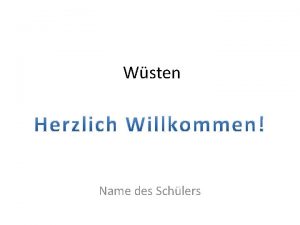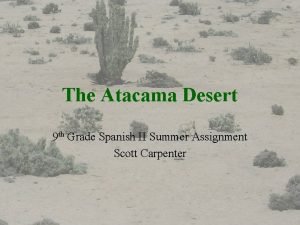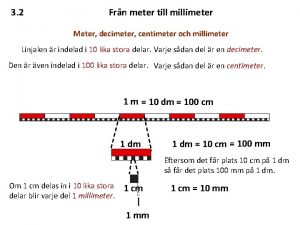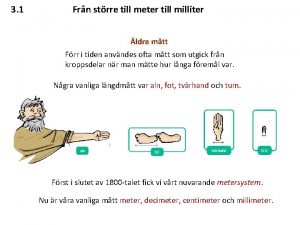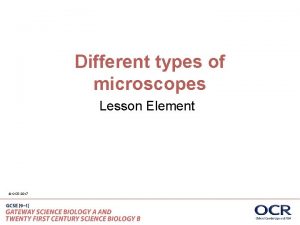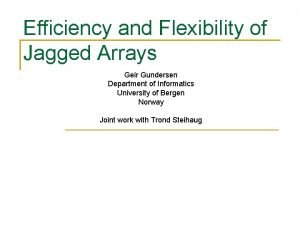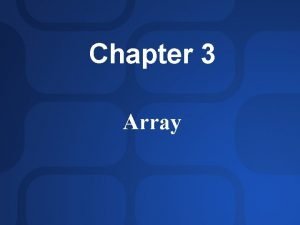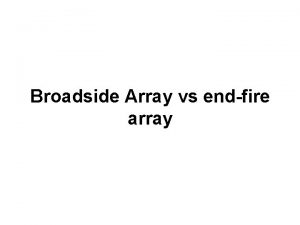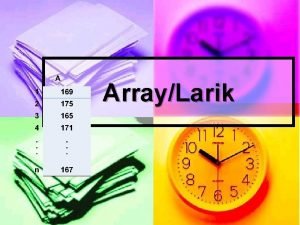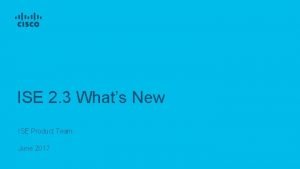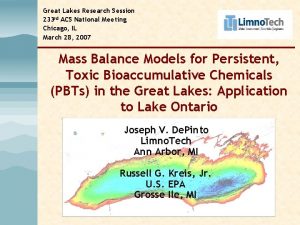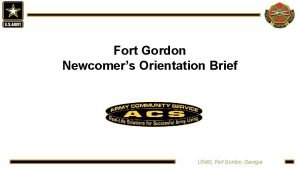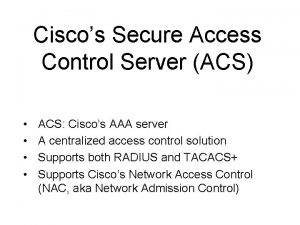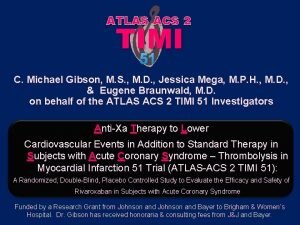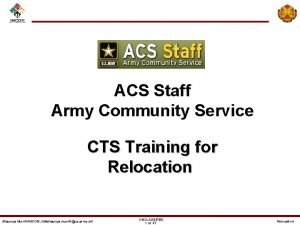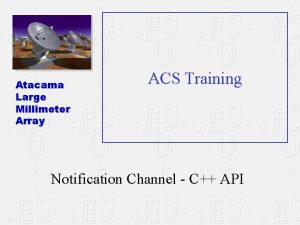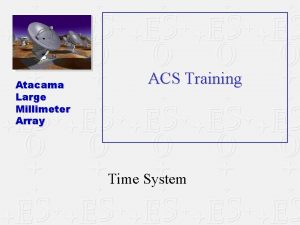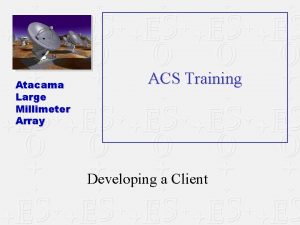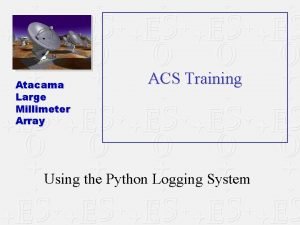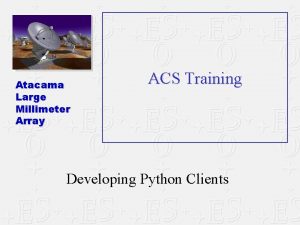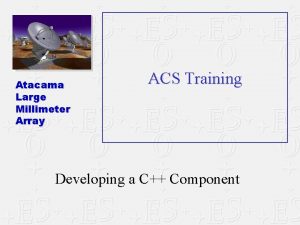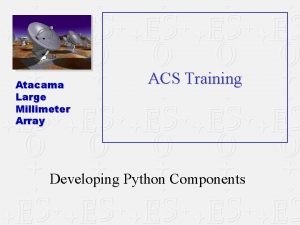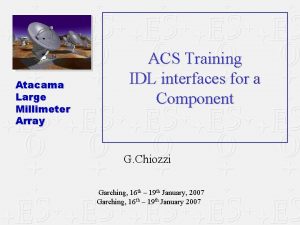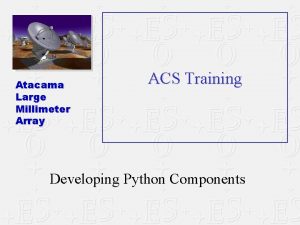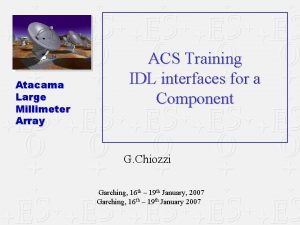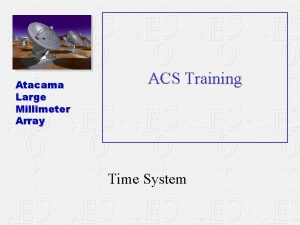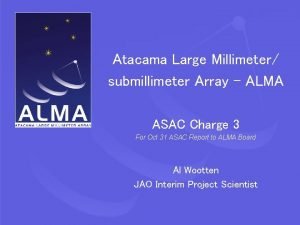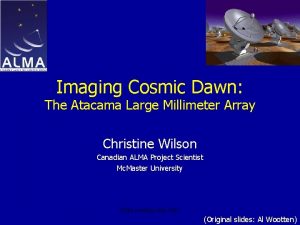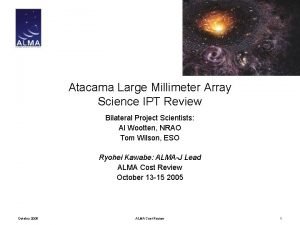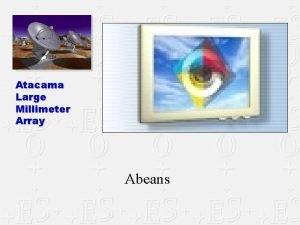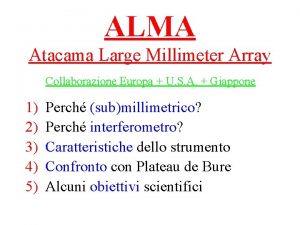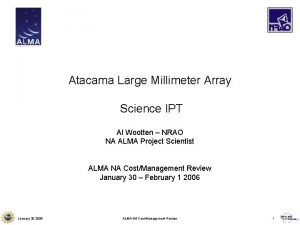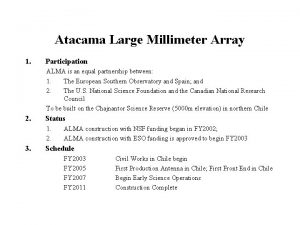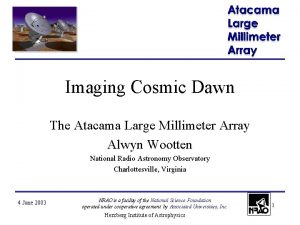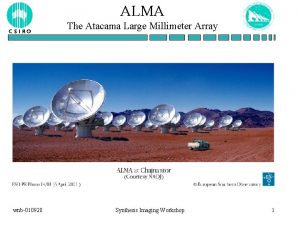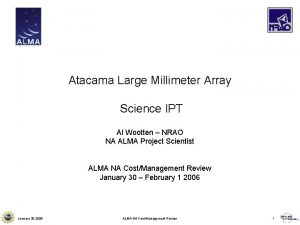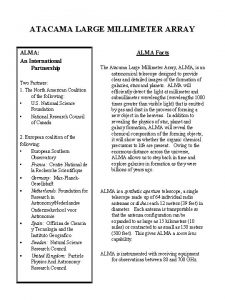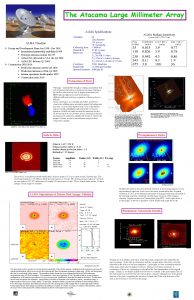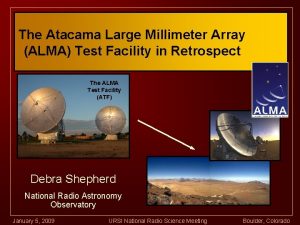Atacama Large Millimeter Array ACS Training Notification Channels





























- Slides: 29

Atacama Large Millimeter Array ACS Training Notification Channels (last updated by Heiko Sommer, Nov. 2009)

What is a Notification Channel? (1) Abstract • A data distribution service that allows many processes to deliver or receive data without “knowing” each other directly. • This data is usually small, used to notify all interested parties of something that happened (“event”, “message”). • Also works for asynchronous communication inside a process. • “Publish-Subscribe”, “Message based system” A B Msg-1 1 g Ms Msg-2 UTFSM Valparaiso, Nov. 2009 C Channel-1 2 Channel-2 ACS Training sg M 2

What is a Notification Channel? (2) In ACS NC Comp. A Comp. B Container UTFSM Valparaiso, Nov. 2009 Msg-1 -1 g s M Msg-2 NC-1 NC-2 Corba (TAO) Notify-Srv ACS Training Msg-2 ACS NC • Service defined by Corba, free implementation from TAO. • The “channel” abstraction is implemented as a remote object in a dedicated “Notify Service” process. • The NC object receives (sync) data from and resends (async) data to registered ACS components or clients. • The “event” data type must be an IDL-defined struct. Client “C” 3

Dis-/ Advantages of using NCs • NCs are an alternative to direct “Request/Reply” calls. – Without using a NC, the most similar design is for the consumer to register a callback directly in the data-supplying process. • NCs decouple the communicating partners – Reduces build time dependencies – Makes partners independent of each others lifetimes (e. g. subscribe to events before the sender has been created) • NCs can protect the sender from slow receivers (within the limits of buffering and loss policies) • NC may offer the flexibility of attaching one NC’s output to another NC’s input, like Unix pipes. Intermediate filtering and data interception possible. This is not yet used in ACS projects. • Use of NCs makes debugging the system more difficult. • Don’t use NCs for massive data transfers! (-> bulk data) • Don’t use NCs for high-frequency and highly structured data. Each packet will contain complete self-description of the data (Corba Any). UTFSM Valparaiso, Nov. 2009 ACS Training 4

UTFSM Valparaiso, Nov. 2009 ACS Training 5

Using NCs in ACS - Overview • ACS provides a simplified API to access and use NCs. – A Supplier class that takes events for a given NC. – A Consumer class that delivers events from a given NC to a user’s registered callback method. – These classes are available for Java, C++, Python – ACS NC classes work with components and for client applications. – Nearly all CORBA complexity is hidden from developers. ACS only supports the push-push model, out of the many Corba choices. • Configuration of NCs via the CDB • Conventions: – the IDL structs used as event data types should have names ending in “Event”. – Channels are named using const strings defined in IDL, to ensure same channel names used in C++, Java, Py – Send / receive only one type of event per NC. UTFSM Valparaiso, Nov. 2009 ACS Training 6

The ACS NC Supplier class • • An ACS class designed to publish events Constructed for a particular NC. Creates the NC if necessary. Immediately connects to the NC. Method “publish. Event” takes IDL-struct-defined objects. Can disconnect from the NC, releasing remote resources. May destroy the NC. Normally not used, because other publishers may be affected (requires sync’ing). UTFSM Valparaiso, Nov. 2009 ACS Training 7

The ACS NC Consumer class (1) • • An ACS class designed to process structured events. The developer must – – • • • create a subclass of Consumer for each notification channel and override the process. Event method or provide a “handler function” to a Consumer object (delegation). Whether that particular object can process all types of events on a given channel is up to the developer to decide. Corba calls the push_structured_event method when an event comes in. The ACS class then pre-processes the data and forwards it to the user code. The developer has no control over when the event data gets injected. Just needs to react (and return control quickly!). UTFSM Valparaiso, Nov. 2009 ACS Training 8

The ACS NC Consumer class (2) • • Subscribe to and unsubscribe from all types of events. Create an NC to subscribe to, if it’s not yet created. Specify when it is ready to start receiving events. Suspend and resume the connection to the channel at any time. Disconnect from the NC when done (Important!) Filter out events it does not want to process. Get notified when a Supplier begins publishing a new type of event and dynamically subscribe to it. The same holds true when subscriptions are no longer offered. UTFSM Valparaiso, Nov. 2009 ACS Training 9

Event Filtering is provided on three different levels: • A consumer of structured events from “Channel-A” will never see structured events published by “Channel-B”. • Consumers will only process structured events for the type_name’s they are subscribed to (which can also be dynamically unsubscribed from). • Rarely used: The ability to “ignore” entire events based on various values in the structured event. A consumer provides the type_name and a filter string based on extended trader constraint language. This string can be as simple as “$Temperature<=100” for simple CORBA types (implying there is a CORBA integer in the structured event and it is named “Temperature”). This becomes non-trivial for filtering user-defined IDL structs though… UTFSM Valparaiso, Nov. 2009 ACS Training 10

NC configuration • • NCs can be configured in the CDB. The ACS NC libs read and apply this configuration. To do this, provide an XML in the ACS CDB: $ACS_CDB/MACI/Channels/your. Channel. xml which must follow the schema: $ACSROOT/config/CDB/schemas/Event. Channel. xsd (online link) • There a host of debug, quality of service, and administrative properties that can be configured. This is not used much in practice, therefore we don’t present the details here. See the Event. Channel schema for the detailed description. UTFSM Valparaiso, Nov. 2009 ACS Training 11

New Features (1) • Since ACS 8. 1 the Notification Service can be restarted safely after a crash – automatically by ACS daemons – or manually. • The consumer objects will then be reconnected automatically. • The supplier objects can continue to use the old NC reference. • However, while the Notify Service (and thus the NC) are unavailable, the supplier will get exceptions when publishing events. • The Supplier class can store failed events in a circular buffer and resend them after reconnection to the NC, if the user registers an Event. Processing. Callback object with callback methods for the different good and bad cases of event delivery: – Event Sent: The event was (eventually) sent successfully to the NC – Event Stored in queue: The event could not be sent and was stored – Event Dropped: The event was removed from the temporal queue and will be discarded. UTFSM Valparaiso, Nov. 2009 ACS Training 12

New Features (2) • ACS allows users to start many Notify Service processes, and to decide on a per-NC basis in which process the NC is hosted. – The default Notify Service is started along with all ACS services – Additional Notify Service instances can be started with acs. Notify. Service -s -w -n Special. Notify. Service or through the ACS services daemon. • CDB config file CDB/MACI/Channels. xml : Default <Notification. Service. Mapping Default. Notification. Service="Notify. Event. Channel. Factory"> <Domains> <_ Name="ALARMSYSTEM" Notification. Service="Alarm. Notify. Service"/> </Domains> <Channels_> <_ Name=“RISKY_NC_*" Notification. Service=“Special. Notify. Service"/> </Channels_> Channel “RISKY_NC_BADDATA” </Notification. Service. Mapping> will run inside “Special. Notify. Service” UTFSM Valparaiso, Nov. 2009 ACS Training 13

Current Development • ACS is in the process of integrating the Supplier and Consumer classes with the Container. Services, instead of offering them as a stand-alone library. – ACS can clean up better to avoid remote memory leaks • We are working on offering a common interface for CORBAbased NCs and the DDS standard – See http: //www. omg. org/technology/documents/dds_spec_catalog. htm – DDS also publish-subscribe, w/o central service – Performance and jitter often better than Corba NC, especially when network multicast gets used. – Less self-descriptive than NCs, makes generic clients hard to implement. • Construction of a new Event GUI, see next slide. UTFSM Valparaiso, Nov. 2009 ACS Training 14

Event GUI (new dev. ) UTFSM Valparaiso, Nov. 2009 ACS Training 15

Questions? ? ? UTFSM Valparaiso, Nov. 2009 ACS Training 16

Quality of Service Properties • • • Event. Reliability - Handles the kind of guarantee that can be given for a specific event getting delivered to a Consumer. Represented by Best. Effort or Persistent. Connection. Reliability - Handles the kind of guarantee that can be given for the connections between the Notification Channel and its clients. Can have the same values as Event. Reliability. Stop. Time - Specifies an absolute expiry date. Timeout - Specifies a relative expiry date. Start. Time - Specifies an absolute time after which the event will be discarded. Priority. Order - Used to control the order of the events delivered to the consumers. Default value is 0 but ranges from – 32767 to 32767. UTFSM Valparaiso, Nov. 2009 ACS Training 17

Quality of Service Properties (continued) • • • Order. Policy - Used by a proxy to arrange events in the dispatch queue. Can be the following values: Any. Order, Fifo. Order, Priority. Order, and Deadline. Order. Discard. Policy - Defines the order in which events are discarded when overflow of internal buffers occur. Holds the same values as Order. Policy plus an addition value: Lifo. Order. Maximum. Events. Per. Consumer - Defines a bound for the maximum number of events the channel will queue for a given consumer. The default value is 0. Maximum. Batch. Size - Not relevant to the ACS API! Pacing. Interval - Not relevant to the ACS API! UTFSM Valparaiso, Nov. 2009 ACS Training 18

Administrative Properties • • Max. Queue. Length - Specifies the maximum number of events the channel will queue internally before starting to discard events. Max. Consumers - Defines the maximum number of consumers that can be connected to a particular channel. Max. Suppliers - Defines the maximum number of suppliers that can be connected to a particular channel. Reject. New. Events - Defines how to handle events when the number of events exceeds Max. Queue. Length value. Set this Boolean value to true for IMPL_LIMIT exceptions to be thrown. A false value implies events will be discarded silently. UTFSM Valparaiso, Nov. 2009 ACS Training 19

What is the TAO Notification Service? CORBA-based Notification Service is a service which extends the existing OMG Event Service, adding to it the following new capabilities: • The ability to transmit events in the form of a well-defined data structure, in addition to Anys and Typed-events as supported by the existing Event Service. • The ability for clients to specify exactly which events they are interested in receiving, by attaching filters to each proxy in a channel (not yet implemented in acsnc). • The ability for the event types required by all consumers of a channel to be discovered by suppliers of that channel, so that suppliers can produce events on demand, or avoid transmitting events in which no consumers have interest. UTFSM Valparaiso, Nov. 2009 ACS Training 20

What is the TAO Notification Service? • • • The ability for the event types offered by suppliers to an event channel to be discovered by consumers of that channel so that consumers may subscribe to new event types as they become available. The ability to configure various quality of service properties on a per -channel, perproxy, or per-event basis. An optional event type repository which, if present, facilitates the formation of filter constraints by end-users, by making information about the structure of events which will flow through the channel readily available. UTFSM Valparaiso, Nov. 2009 ACS Training 21

What is a Structured Event? • • • A structured event is a data structure defined in IDL that is sent across the Notification Service by suppliers to consumers. There is only one field that must be “filled-out”: type_name. Consumers subscribe events based on this field. The optional fields: – event_name is basically an arbitrary string defined by the developer. – Of particular interest to the developer: filterable_data[]. This is a sequence of CORBA properties (string/CORBA Any pairs) that can be filtered using the extended trader constraint language discussed above. UTFSM Valparaiso, Nov. 2009 ACS Training 22

Architectural Perspective UTFSM Valparaiso, Nov. 2009 ACS Training 23

Structured Events UTFSM Valparaiso, Nov. 2009 ACS Training 24

UTFSM Valparaiso, Nov. 2009 ACS Training 25

IDL for other NC Courses #pragma prefix "alma" module ACSCOURSE_MOUNT { /** @interface Mount 5 * Nearly identical to Mount 1 except for the fact that this example publishes/consumes events from an event channel and that exception handling has been ommitted. */ interface Mount 5 : ACS: : ACSComponent { /** (Pre)sets a new non-moving position for the antenna. The position coordinates are given in azimuth and elevation. * @param az position azimuth (degree) * @param elev position elevation (degree) * @htmlonly * <hr> * @endhtmlonly */ void objfix (in double az, in double elev); }; UTFSM Valparaiso, Nov. 2009 ACS Training 26

IDL for other NC Courses /** The name of the event channel our interface implementation will send events to. It is specified in the IDL instead of the implementation language to make it harder for developers * of Consumer applications to confuse names (i. e. , using "Mount. Channel" instead of "mountchannel". */ const string MOUNT_CHANNEL = "mountchannel"; /** * This IDL structure defines an "event" type that will sent across the network to any consumers subscribed to it */ struct Mount. Event. Data { double Azimuth; double Elevation; }; }; UTFSM Valparaiso, Nov. 2009 ACS Training 27

ACSEvent. Admin The ACSEvent. Admin graphical user interface was created and implemented in the Python programming language to administer and monitor all ALMA event channels. It supports the following operations: • Creating new notification channels • Reconfiguring a channel’s properties at run-time • Destroying notification channels • Obtaining a list of all active channels • Obtaining the total number of suppliers and consumers connected to a channel • Obtaining the total number of events that have been published on a channel • Obtaining a list of all types of ALMA events that have been published on a channel • Monitoring all events using the callback design pattern UTFSM Valparaiso, Nov. 2009 ACS Training 28

Event Browser (superseded by Event GUI) UTFSM Valparaiso, Nov. 2009 ACS Training 29
 Wsten
Wsten Atacama desert
Atacama desert Taiga biome
Taiga biome Atacama
Atacama Casualty assistance officer army
Casualty assistance officer army Meter decimeter
Meter decimeter Millimeter in a sentence
Millimeter in a sentence Nearest millimeter example
Nearest millimeter example Finding metric length
Finding metric length Strre
Strre Millimeter cloud radar
Millimeter cloud radar Objectives of pathology
Objectives of pathology Millimeter table
Millimeter table Land grid array vs pin grid array
Land grid array vs pin grid array Array dimensi 3
Array dimensi 3 Jagged array vs multidimensional array
Jagged array vs multidimensional array Associative array vs indexed array
Associative array vs indexed array Broadside array and endfire array difference
Broadside array and endfire array difference Arik adalah
Arik adalah Upper triangular array adalah
Upper triangular array adalah Perbedaan array 1 dimensi 2 dimensi dan multidimensi
Perbedaan array 1 dimensi 2 dimensi dan multidimensi Photovoltaic array maximum power point tracking array
Photovoltaic array maximum power point tracking array Social media identifier
Social media identifier Rd acs
Rd acs Mflc fort gordon
Mflc fort gordon Cisco secure access control server for windows
Cisco secure access control server for windows Aklais plankums
Aklais plankums Preventive services (acs)
Preventive services (acs) Atlas timi 51
Atlas timi 51 Acsstaff.org
Acsstaff.org
